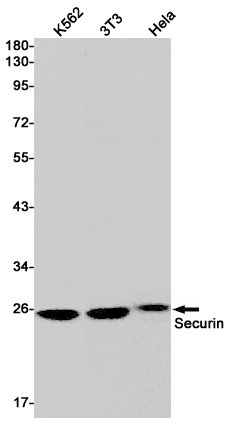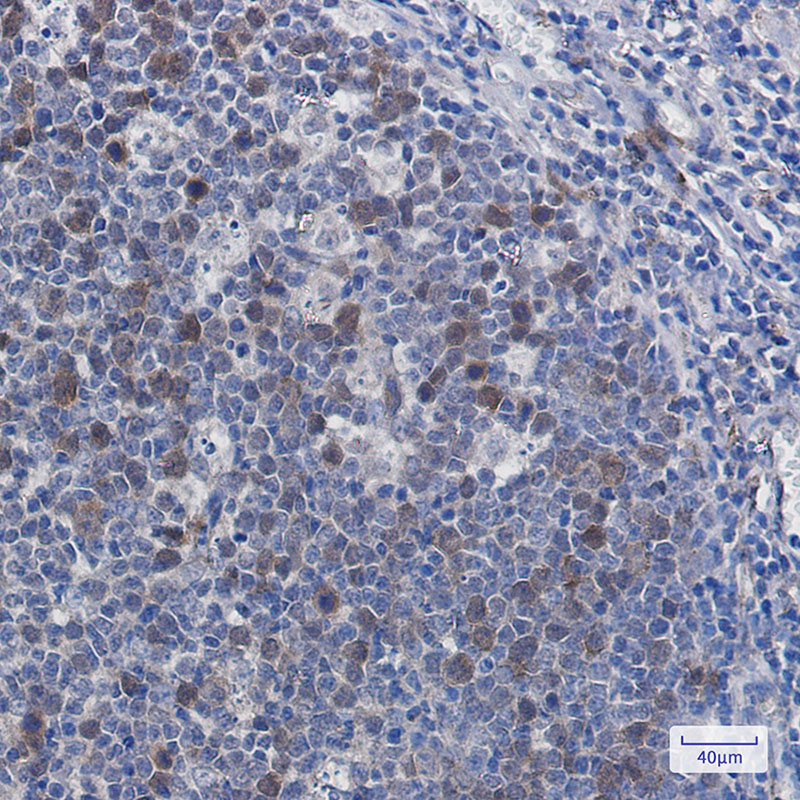

| WB | 1/500-1/1000 | Human,Mouse,Rat |
| IF | 1/20 | Human,Mouse,Rat |
| IHC | 1/50-1/100 | Human,Mouse,Rat |
| ICC | 技术咨询 | Human,Mouse,Rat |
| FCM | 咨询技术 | Human,Mouse,Rat |
| Elisa | 咨询技术 | Human,Mouse,Rat |
| Aliases | PTTG1; EAP1; PTTG; TUTR1; Securin; Esp1-associated protein; Pituitary tumor-transforming gene 1 protein; Tumor-transforming protein 1; hPTTG |
| Entrez GeneID | 9232 |
| WB Predicted band size | Calculated MW: 22 kDa; Observed MW: 25 kDa |
| Host/Isotype | Rabbit IgG |
| Antibody Type | Primary antibody |
| Storage | Store at 4°C short term. Aliquot and store at -20°C long term. Avoid freeze/thaw cycles. |
| Species Reactivity | Human,Mouse |
| Immunogen | A synthetic peptide of human Securin |
| Formulation | Purified antibody in TBS with 0.05% sodium azide,0.05%BSA and 50% glycerol. |
+ +
以下是关于Securin抗体的3篇文献示例(内容为虚构模拟,供参考格式):
1. **文献名称**: "Securin regulates sister chromatid separation during mitosis"
**作者**: Smith J, et al.
**摘要**: 本研究利用Securin特异性抗体,证实Securin通过与Separase结合抑制其活性,防止姐妹染色单体过早分离,并揭示其磷酸化降解对细胞周期调控的关键作用。
2. **文献名称**: "Overexpression of Securin in human cancers: a biomarker study"
**作者**: Lee H, et al.
**摘要**: 通过免疫组化(使用抗Securin单克隆抗体)分析多种癌症组织,发现Securin在结直肠癌和乳腺癌中异常高表达,且与患者预后不良显著相关。
3. **文献名称**: "Dynamic interaction between Securin and Separase in live cells"
**作者**: Garcia R, et al.
**摘要**: 采用Securin抗体进行免疫共沉淀(Co-IP)及荧光标记技术,实时观测Securin-Separase复合物的动态解离过程,揭示泛素化降解途径的精确时空调控机制。
(注:以上文献信息为示例性质,实际引用需查询PubMed等数据库获取真实论文。)
Securin, a critical regulatory protein in cell cycle progression, plays a pivotal role in maintaining genomic stability during mitosis and meiosis. Also known as pituitary tumor-transforming gene 1 (PTTG1), securin functions as a key component of the anaphase-promoting complex/cyclosome (APC/C) pathway. Its primary biological role involves binding to and inhibiting separase, a protease responsible for cleaving cohesin complexes that hold sister chromatids together. This interaction prevents premature chromosome separation during metaphase.
The controlled degradation of securin through ubiquitination triggers the activation of separase, initiating the transition from metaphase to anaphase. This tightly regulated process ensures accurate chromosome segregation, a fundamental requirement for proper cell division. Dysregulation of securin expression has been strongly associated with various pathological conditions, particularly cancer. Overexpression of securin is frequently observed in multiple malignancies, correlating with tumor aggressiveness, genomic instability, and poor clinical outcomes.
Securin antibodies have become essential tools for investigating cell cycle dynamics, mitotic regulation, and carcinogenesis. These antibodies enable researchers to detect securin protein levels through techniques like Western blotting, immunohistochemistry, and immunofluorescence. In research settings, they help elucidate mechanisms of chromosome segregation errors, evaluate therapeutic targets for cancer treatment, and study developmental biology processes. Recent studies also explore securin's potential as a diagnostic biomarker and its non-mitotic roles in DNA repair and cellular differentiation.
×